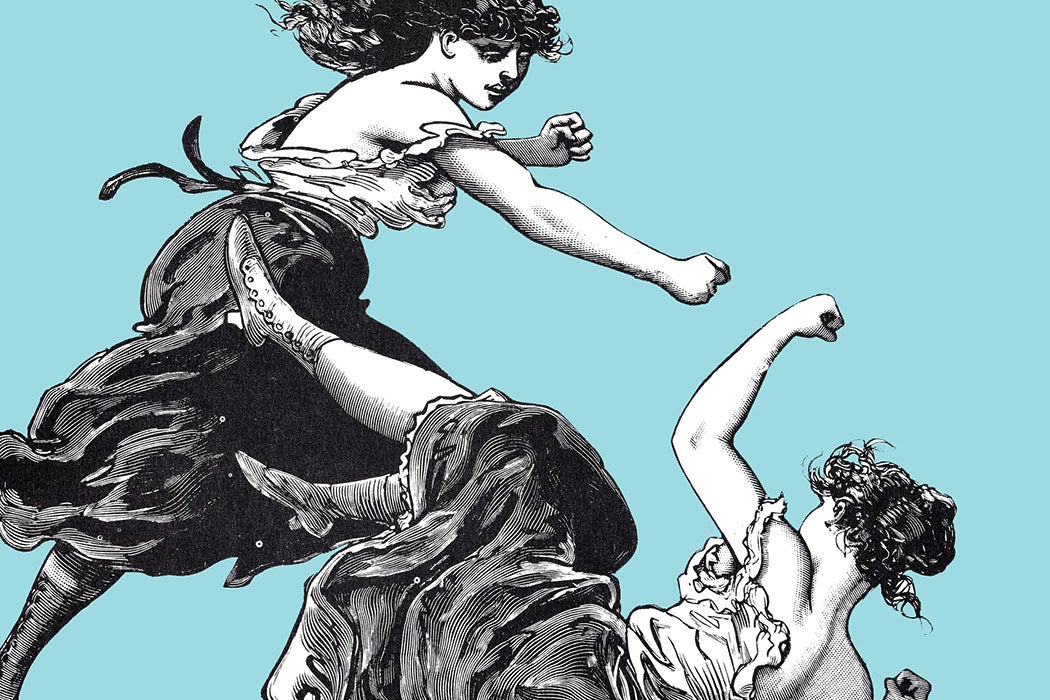Elizabeth Wilkinson had a score to settle. Writing to the London Journal in 1722, she informs its readers that she and Hannah Highfield (some sources cite her as Hyfield) “had some words.” And though words might have started it, they weren’t going to end it. Wilkinson, for all to see, challenged Highfield to a fight:
“I…do invite her to meet me on the stage and box with me for three guineas,” she wrote, “each woman holding half-a-crown in each hand, and the first woman that drops her money to lose the battle.”
Highfield accepted that invitation, replying in a later issue and promising “that she will not fail…to give her more blows than words, desiring home blows, and of her no favor. She may expect a good thrumping.”
Though calling out your enemy in a newspaper ad might be unusual, the fight certainly wasn’t. As historian Randy Roberts writes, “female pugilism was so popular that the women crowned their first championess…at approximately the same time as the males proclaimed their first champion.” That crown was won in 1726. Women have long been part of the boxing world even as gender norms changed and shifted around them.
Although people were fighting for fun and profit well before, there were no established boxing rules until 1743. As Roberts points out, boxing evolved as “a highly brutal and savage game.” For example, hitting opponents with the bottom of the fist was a common tactic, as were “gouging, hair pulling, ear twisting, wrestling throws, and kicking.” After observing a fight in 1728, a Swiss writer noted that the women used “a sort of two-handed sword, three or three and a half feet in length” to fight one another. As athlete and sports historian Peter Radford describes the same fight, one woman “was cut across her forehead and the fight was stopped for the wound to be sewn up by a surgeon.” She gathered up her strength to continue after a big glass of a stiff drink. The fight was eventually called after the woman was badly cut a third time.
Yet the appeal of the sport only grew. As kinesiologist Cathy van Ingen explains, by the early 1800s, much of the “boxiana”—written accounts of matches, biographical sketches, and media commentary—was found in “sports periodicals such as the National Police Gazette and The Ring magazine.” Though the former was a tabloid featuring “buxom showgirls, scandals, hangings, red-tinted paper, and spicy stories,” it regularly covered women’s boxing. The bouts ranged from showdowns in theaters and saloons to the more refined and rule-based fights held in sporting clubs. Women fighters often took a page from history and posted ads in the magazine to challenge competitors to matches.
As van Ingen points out, however, the magazine only reported on white fighters and “oscillated between celebration and ridicule.” Like other sports, boxing’s color line was a defining factor. Though she writes that scholarship on Black male boxing history continues to grow, “scholars continue to pay insufficient attention to black female pugilists.”
Looking through historic boxiana, van Ingen has recovered some of this history. She discovered an 1882 match between Bessie Williams and Josephine Green, both of whom were trained by their husbands in “the manly art.” Williams, the ultimate winner, took home $20 and “the title of the colored lady championship.” Van Ingen also found that other Black women boxers served as sparring partners and likely as entertainment in Harry Hill’s, a New York saloon.
Weekly Newsletter
Perhaps the best documented early Black women boxers were Emma Maitland and Aurelia Wheeldin, who “were part of the first African-American group of dancing girls to appear at the Moulin Rouge in Paris,” according to van Ingen. After their Moulin Rouge contract ended, they styled themselves as the “Tea for Two Girls” and created an act “which included three rounds of boxing.”
In boxing’s early days, women weren’t just participating in a sport, they were also challenging norms. As Radford writes, “women were clearly unwilling to sit on the sidelines and watch; they were active, spirited, and popular participants.”







